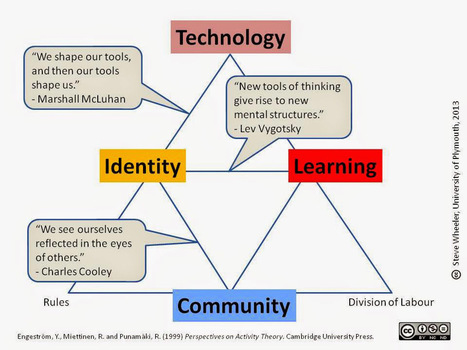A personal learning environment (PLE) is a solution for keeping up with the rapid pace of knowledge change. Some say it is a concept, while others say it is a technology.
I think a good definition is this: a self-directed and evolving environment of tools, services and resources organized by a person seeking a way to accomplish lifetime learning, to create, and to connect with others of similar interests.
Because it is personalized, everyone’s PLE will be unique. Because it is collaborative, information may be continually created and shared. In the workplace, designing a personal learning environment has the potential to partially replace conventional courses.
Learn more / En savoir plus / Mehr erfahren:
http://www.scoop.it/t/21st-century-learning-and-teaching/?tag=PLE
http://www.scoop.it/t/21st-century-learning-and-teaching/?tag=design
https://gustmees.wordpress.com/2014/10/03/design-the-learning-of-your-learners-students-ideas/
Via Gust MEES



 Your new post is loading...
Your new post is loading...



















A personal learning environment (PLE) is a solution for keeping up with the rapid pace of knowledge change. Some say it is a concept, while others say it is a technology.
I think a good definition is this: a self-directed and evolving environment of tools, services and resources organized by a person seeking a way to accomplish lifetime learning, to create, and to connect with others of similar interests.
Because it is personalized, everyone’s PLE will be unique. Because it is collaborative, information may be continually created and shared. In the workplace, designing a personal learning environment has the potential to partially replace conventional courses.
Learn more / En savoir plus / Mehr erfahren:
http://www.scoop.it/t/21st-century-learning-and-teaching/?tag=PLE
http://www.scoop.it/t/21st-century-learning-and-teaching/?tag=design
https://gustmees.wordpress.com/2015/07/19/learning-path-for-professional-21st-century-learning-by-ict-practice/
https://gustmees.wordpress.com/2014/10/03/design-the-learning-of-your-learners-students-ideas/
A personal learning environment (PLE) is a solution for keeping up with the rapid pace of knowledge change. Some say it is a concept, while others say it is a technology.
I think a good definition is this: a self-directed and evolving environment of tools, services and resources organized by a person seeking a way to accomplish lifetime learning, to create, and to connect with others of similar interests.
Because it is personalized, everyone’s PLE will be unique. Because it is collaborative, information may be continually created and shared. In the workplace, designing a personal learning environment has the potential to partially replace conventional courses.
Learn more / En savoir plus / Mehr erfahren:
http://www.scoop.it/t/21st-century-learning-and-teaching/?tag=PLE
http://www.scoop.it/t/21st-century-learning-and-teaching/?tag=design
https://gustmees.wordpress.com/2015/07/19/learning-path-for-professional-21st-century-learning-by-ict-practice/
https://gustmees.wordpress.com/2014/10/03/design-the-learning-of-your-learners-students-ideas/
L'autodidaxie comme discipline d'apprentissage retrouvera-t-elle la cote auprès des employeurs? Pourquoi pas offrir le diplôme à la carte ?